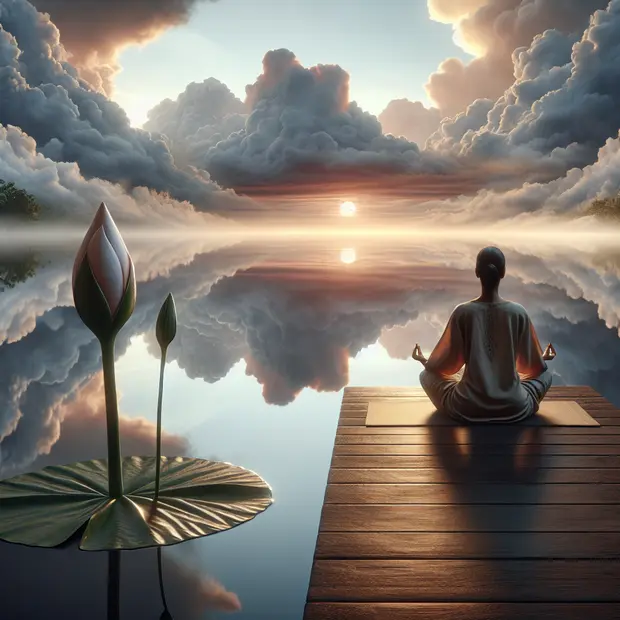5 Yoga Poses for Stress Relief You Can Do Anytime, Anywhere
Discover 5 simple yet effective yoga poses that can help alleviate stress and can be done anytime, anywhere. No need for any equipment, just a quiet space and a few minutes of your time.

In today's fast-paced, ever-changing world, stress and anxiety have become almost ubiquitous companions for many individuals. Whether it's the mounting pressures at work, the complexities of managing personal relationships, or the relentless bombardment of information through various media, it's easy to feel overwhelmed and steeped in tension. You're not alone if you find yourself struggling to navigate through these tumultuous times. However, there is no need for despair. There's a solution that's as old as civilization itself – Yoga.
Yoga, with its origins steeped in the ancient civilizations of the East, has now gained global recognition as a powerful antidote to stress. It's a holistic blend of physical postures, breathing exercises, and meditation practices that work in harmony to balance your mind, body, and spirit. Through regular practice, you not only build physical strength and flexibility but also cultivate inner peace and resilience, creating an inner sanctuary amidst the chaos of the outer world.
So, next time you find yourself drowning in stress, remember to turn to Yoga. Allow this age-old practice to guide you towards tranquility and equilibrium, transforming stress into a catalyst for growth and self-awareness. With Yoga, you can not only survive in this demanding world but thrive amidst its challenges, becoming a beacon of calm and serenity.
Why Choose Yoga for Stress Relief?
Yoga is a powerful tool for stress relief. It acts as a sanctuary, a safe space where the mind can find rest from the constant hum of life. Not only does it help to improve physical fitness, it can also reduce stress and anxiety, enhance mood, and improve overall quality of life. The beauty of Yoga is in its simplicity and adaptability; it's a practice that is accessible to everyone, regardless of age or fitness level. You don't need any expensive equipment, just a quiet space, a few minutes of your time, and an open mind.
Yoga is not just exercise; it's a way of life. It teaches us how to breathe properly, how to tune into our bodies and listen to what they're telling us. This conscious, mindful approach to life not only aids in physical wellbeing, but also spills over into our mental and emotional health, equipping us with tools to manage and alleviate stress.
Here are five simple yet effective yoga poses that you can do anytime, anywhere to help alleviate stress. Each of these poses is designed to help you focus on your breath, bringing you into the present moment and allowing your body to relax and release tension.
Remember, the goal is not to perfect the pose, but rather, to use each pose as a tool for mindfulness - to bring your attention to your breath, to the sensations in your body, and to the stillness within. This mindful practice not only helps to reduce stress levels, but also fosters a deeper connection with yourself, leading to improved mental clarity, increased self-awareness, and a sense of inner peace.
So, why wait? Embark on your yoga journey today, and discover the transformative power of this ancient practice. Whether you're a seasoned yogi or a complete beginner, you'll soon find that yoga is more than just a workout - it's a way of life that leads to greater health, happiness, and peace of mind.
1. Child's Pose (Balasana)
Child's pose, also known as Balasana in Sanskrit, is often considered a restful, calming pose that can be sequenced between more challenging poses during a yoga session. This pose is not just simple, but it's also an effective way to relax both your body and mind. By allowing your forehead to come into contact with the floor, you're inviting a sense of grounding and stability, which can help reduce stress and anxiety.
Balasana is a versatile pose that can be modified to suit different flexibility levels and body types, making it a wonderful addition to any yoga practitioner's routine, regardless of their experience level. Let's explore how to perform the Child's Pose step by step:
- Begin by sitting back on your heels, ensuring that your knees are hip-width apart. This starting position is sometimes known as Vajrasana or Thunderbolt Pose.
- From there, gently lean forward. As you do this, stretch your arms out in front of you, extending through your fingertips to elongate your spine and create space in your torso.
- Next, rest your forehead on the floor. If this isn't possible due to flexibility constraints, don't worry. You can stack your fists or place a yoga block or a pillow under your forehead. This modification can help you maintain the integrity of the pose without strain.
- Close your eyes and direct your attention inwards. Focus on your breath, taking slow, deep breaths. Try to breathe through your nose, which can help to calm your nervous system and deepen your sense of relaxation.
- Hold this pose for as long as you feel comfortable, ideally for a few minutes. This allows the benefits of the pose to fully materialise. Remember, yoga is not about pushing yourself to the limit, but about finding comfort and peace within each pose.
By incorporating Child's Pose into your yoga practice, you are embracing a moment of peace and rest, giving your body the permission to relax and rejuvenate. Enjoy the tranquillity that Balasana brings!
2. Cat-Cow Pose (Marjaryasana-Bitilasana)
The Cat-Cow pose, also known as Marjaryasana-Bitilasana, is an incredibly versatile yoga sequence. It is gentle by nature, making it a perfect starting point for beginners, yet beneficial for yogis of all levels. The primary objective of this pose is to loosen up the spine, preparing the body for more challenging poses. Apart from its physiological benefits, the Cat-Cow pose also provides significant mental benefits. It encourages calmness and clarity of mind, making it an excellent stress reliever in today's fast-paced world.
- To begin, position yourself on your hands and knees in a tabletop position. Make sure your hands are directly under your shoulders and your knees are directly under your hips for maximum stability and comfort.
- Take a deep breath in, and as you do so, gently arch your back. Lift your chest and tailbone towards the ceiling. This is the Cow pose, a stance that opens up the chest and encourages deep, immersive breathing.
- As you exhale, switch to the Cat pose. Round your spine, tuck in your tailbone, and bring your chin towards your chest. This pose stretches the muscles of the back and neck, providing a soothing sensation that permeates the entire body.
- Flow gracefully and fluidly between these two poses, synchronizing your movement with your breath. This flowing movement not only enhances flexibility but also enhances mindfulness, connecting the body, breath, and mind.
- Engage in this sequence for several breaths, enjoying the serenity and calm that each breath brings. Feel the stress melting away as you immerse yourself in the rhythm of the Cat-Cow Pose.
Remember to listen to your body as you practice this pose. If any discomfort arises, lessen the intensity of the pose or take a break. The Cat-Cow Pose is about finding balance and harmony within, so be patient and kind to yourself as you explore this rejuvenating sequence.
3. Downward Facing Dog (Adho Mukha Svanasana)
Known as one of the most practiced poses, the Downward Facing Dog, or Adho Mukha Svanasana, is an invigorating and powerful pose that rejuvenates the body and mind. Its benefits are vast—it not only stretches the hamstrings, shoulders, and calves, but also strengthens the arms and legs, increasing overall body flexibility and vigor.
Its inversion aspect aids in improving the circulation of blood throughout the body, relieving stress, and enhancing concentration—a perfect setup for a more focused yoga session.
- Begin by placing your hands and knees in a tabletop position. Your wrists should be directly under your shoulders, and your knees should be directly under your hips.
- Exhale as you tuck your toes under and gently lift your knees off the floor. Gradually send your hips back and then raise them up, guiding your body into an inverted 'V' shape. Make sure your feet are hip-width apart, and your hands are shoulder-width apart.
- Next, press your palms firmly into the floor and rotate your upper arms outwards to open the chest. This action creates the required space in your shoulders and prevents unnecessary strain.
- Ensure your neck is in a relaxed state, allowing your head to hang freely. Keep your gaze towards your navel, promoting a sense of inward focus.
- Hold this pose for a few breaths, allowing yourself to feel the stretch and strength in your body. With each exhalation, try to deepen your stretch and push your chest closer towards your thighs.
- Experience the rejuvenating effects of this pose before moving on to the next. To release, gently bend your knees and return to your starting position. Remember to move at a pace that feels comfortable for you.
The Downward Facing Dog is truly a cornerstone of yoga, offering both physical and mental benefits. It's a pose that is worth perfecting and incorporating into your regular yoga practice.
4. Tree Pose (Vrksasana)
The Tree Pose, or Vrksasana, is a standing posture that offers an array of benefits. This pose, often seen as a symbol of tranquility and steadiness, not only bolsters your physical balance but also promotes mental equilibrium. It fosters focus and mental clarity, making it an excellent stress-busting posture. By requiring concentration, it effectively diverts your mind from day-to-day worries, allowing you to find a moment of peace amidst the chaos.
Performing this pose might seem challenging at first, but with regular practice, you'll find it increasingly easier and more beneficial. Here's a step-by-step guide to help you perfect your Tree Pose.
- Begin by standing tall, ensuring your feet are hip-width apart. This will serve as your stable base, helping you maintain balance throughout the pose.
- Now, gently shift your weight onto your right foot. Then, bring the sole of your left foot to the inside of your right thigh. If you're finding this difficult, don't worry. You can place your foot on your lower leg. However, make sure to avoid placing it on the knee to prevent any potential strain.
- Next, bring your hands to your heart center in a prayer position. This not only helps in maintaining balance but also promotes a sense of inner peace. If you're feeling adventurous and well-balanced, you can raise your hands above your head, reaching towards the sky.
- Now, focus on a point in front of you. This will be your 'drishti' or focal point, which is key in maintaining balance in this pose. Then, start breathing deeply. This not only steadies your pose but also calms your mind. After a few breaths, gently release and repeat the pose on the other side.
Remember, yoga is not about perfecting the pose. It's about the journey, and every small step you take towards your well-being counts. So, the next time you feel overwhelmed, just take a few minutes to practice the Tree Pose and experience the peace it brings.
5. Corpse Pose (Savasana)
Corpse pose, also known as Savasana, is a crucial part of any yoga routine. Typically performed at the end of a session, it is a pose of total relaxation, allowing your body and mind to absorb the benefits of your practice. Although it may seem simple, Savasana requires a still, focused mind and a spirit of complete surrender to reap its full benefits.
Why is Savasana so important? It's a moment of stillness in our otherwise busy lives. It's a precious pause, a chance to rest, relax and rejuvenate. It's a time when we can let go of all the stress, the worries, and just be in the present, focusing on our breath and the rhythm of our hearts.
- Lie flat on your back, on a comfortable surface, with your legs slightly apart and your arms resting by your sides, palms facing up towards the sky.
- Close your eyes gently, and take a few deep, calming breaths, consciously releasing tension from every part of your body - from your forehead to your toes.
- Stay in this pose for a few minutes, focusing on your breath and allowing any residual tension or stress to melt away. Visualize each breath filling you with peace and tranquility, and each exhale taking away all your worries and tensions.
Remember that yoga is not about perfecting each pose or reaching a certain goal. It's a journey of self-discovery, self-love, and self-care. It's about connecting with your inner self, finding peace within, and managing stress effectively. So, roll out your mat, strike a pose, and let your worries melt away. Embrace the silence, the stillness and just be in the moment. Namaste.
🌿
Category: Yoga & Fitness
Join the community
Related Articles

Yoga Poses to Avoid with High Blood Pressure for Safe Practice
High blood pressure, also known as hypertension, is a silent...

The Perfect Blend: Combining Yoga and Strength Training for Total Fitness
If you're like many fitness enthusiasts, you're constantly o...

Morning Yoga Routines to Boost Energy and Start Your Day Right
Looking to supercharge your mornings with an energizing yoga...
Latest Articles

What Sleep Deprivation Does to the Brain
Perhaps you've had those days where you've survived on just ...

The Role of Minerals in Rock Formation
Welcome to another enlightening article on HeavenRelax.com, ...

The Importance of Patience in Our Life
In this fast-paced world we live in, patience is often seen ...
Comments
No comments yet. Be the first to comment!